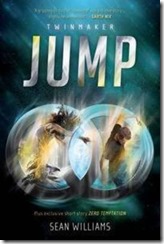At the beginning of October I had a chat with Sean Williams about his new YA book Jump: Twinmaker you can listen to us talk here at Galactic Chat. I had the opportunity to ask some follow up questions below:
Please enjoy:
1. Jump features Fabbers or fabricators, with more widespread use of 3d printing how close do you think we are to seeing technology like them?
On the one hand, you can see existing technologies like cheap 3-D printers and online libraries of downloadable 3-D models heading in exactly this direction, so it’s easy to believe it might be just around the corner. On the other hand, the sheer amount of data and fine-scale manipulation required to make things like food and the Mona Lisa seems far beyond us. The truth is probably somewhere in the middle. Printing objects in hard-to-supply places like space or a battlefield has obvious utility for organisations with enormous R&D budgets, so work is being undertaken right now that will eventually filter down to the mainstream. How long until I can fab a convincing steak that required no animal slaughter? I’d guess twenty years, plus or minus ten. The Mona Lisa? Probably sooner. A living person? A very long way off indeed.
2. What do think would be the most monumental change wrought by matter transference technology if it were to occur now?
That’s a hard question to answer because I suspect everything would change.
Our notion of space and time would shift, since being able to step literally anywhere in a moment or two removes all concept of “between” from everyday life. Once a city on the other side of the planet becomes closer in a very real sense to a destination two blocks away, where you might walk instead of d-matting, that leads to a fundamental restructuring of how we view the world. This goes beyond polyglot societies and complicated national identities. This speaks to how we inhabit the universe around us, and leads to powerful new metaphors for finding our place within it.
Then there’s the way we imagine ourselves as creatures with physical bodies and coherent identities inhabiting those bodies. Any device that can scan your every atom and rebuild you at will leads inevitably to the possibilities of copying, mutation and erasure, all of which put severe pressure on our sense of self. If you can change your physical form any time you like, who are you really? If you can make two or more identical versions of you, which one is really you? If you are deleted en route to your destination, are you really dead? This notion of what’s real and what not is relatively easy to answer when the matter we’re made of is mutable. When it is, we’re in a whole new, and very fascinating territory!
 3. Jump doesn't go into detail on economics, how does the world of Jump operate when you can live in Australia but go to school in the US, how do people make money when people don't have to pay for consumer items?
3. Jump doesn't go into detail on economics, how does the world of Jump operate when you can live in Australia but go to school in the US, how do people make money when people don't have to pay for consumer items?
I talk a little about the economics in the world of Twinmaker in “Face Value”, a short story featuring characters who will appear in the sequel.
What lies at the heart of the economy of this world is that the one irreproducible commodity people can trade is time. You can make a thousand copies of a roast lamb dinner for no cost at all, but if you want someone to make you the original that the copy is taken from, that will cost you, because it takes time to cook the meal. So it’s the ultimate service economy, but with every transaction conducted electronically, of course; there’s no physical money since that could be easily copied too. It’s not fundamentally different from our world in some ways, but utterly different in others.
Governance reflects that. Things like passports and state borders don’t exist anymore, since they just can’t survive in the face of d-mat technology. This is something you’ll see a lot more of in the sequel. I don’t want to burden the books with the nuts and bolts of world-building, but I do want observant readers to know that they are there.
Many thanks to Sean for answering my questions. You can buy your choice of three versions of Jump: Twinmaker (or all three if you really want to make Mr Williams happy) at Booktopia.
Did you enjoy this post? Would you like to read more? You can subscribe to the blog through a reader, by Email orFollow me on twitter.
